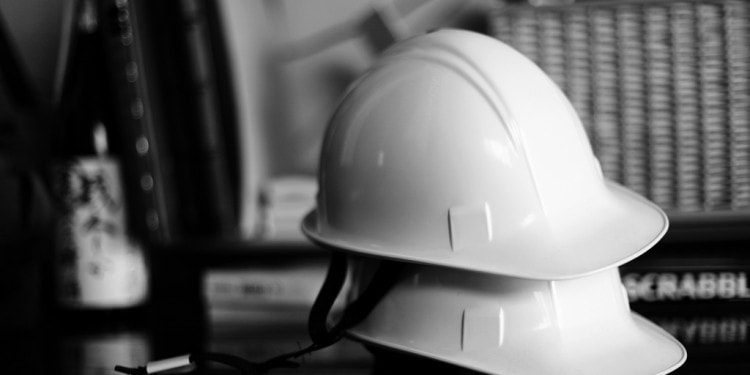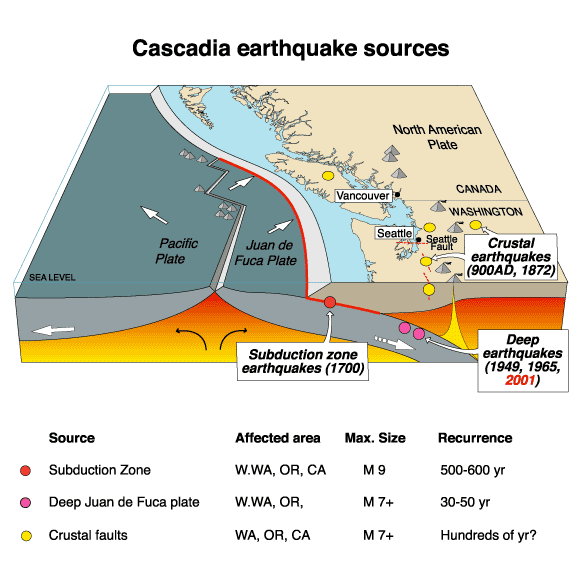The Cascadia Earthquake is long overdue and is expected to hit the West Coast hard anytime between now and the next 50 years.
We know it’s coming. The Big One. The overdue earthquake. We don’t know when, but it’s coming.
For anyone who didn’t know, they found out on July 20th of last year, when an article appeared in The New Yorker that struck fear in the hearts of many West Coast Americans. The article was accompanied by an image of a map of the United States missing a significant piece – most of the West Coast.
It hasn’t happened yet, but it already has a name: the Cascadia earthquake, also known as “The Really Big One,” is expected to cause widespread destruction from Washington all the way down to northern California. But there are many who believe that if you learn enough about it and prepare for it before it hits, the blow will be softened.
Geologists have known about the impending earthquake since the early 1980s, but it wasn’t until the New Yorker article surfaced that many citizens became aware of the event. Ray Weldon, a professor with the University of Oregon Geology and Volcanology department, said that he has been aware of the potential earthquake since before he took a job at the U of O more than 30 years ago.
“It didn’t hit the popular imagination until this article, that was very widely read,” Weldon said. “It’s a little alarmist. It’s a lot greater than what will actually happen. But despite of the panic element, it did raise awareness and that’s vitally important.”
The last documented earthquake on the Cascadia Subduction Zone dates back to the early 1700s. According to Weldon, the estimated date was pinpointed by scientists through a combination of geological evidence, legends from Pacific Northwest Native American tribes, and Japanese historical records. According to studies done by Weldon and other geologists, the Pacific Northwest is more than 50 years overdue for a massive earthquake.
Related article: “WATER, WATER: EVERYWHERE. NOWHERE. AND SUCH PRICES“
 In the Photo: The Cascadia Subduction Zone. Photo Credit: Photo credit: [Public domain], via Wikimedia Commons
In the Photo: The Cascadia Subduction Zone. Photo Credit: Photo credit: [Public domain], via Wikimedia Commons
In a recent presentation, Weldon described what will likely happen in the actual event. Plates on and under the earth’s surface are constantly moving. When two plates lock up and then slip, it creates an earthquake. Over the last several hundred years, the Juan de Fuca plate, located just off the West Coast, and the North American plate have been pressed up against each other, accumulating what’s called “elastic strain.” Eventually, the two plates in the Cascadia Subduction Zone are going to slip, causing “The Really Big One.”
Weldon is part of the National Seismic Hazard team. He participates in creating maps that show how high the risk is for each region. In the most recent map, he said the threat to Oregon has actually been reduced.
The regions in Oregon that will see the largest amount of destruction are the greater Portland area and the coast. Lane County is in what the Oregon Resilience Plan refers to as the “Valley Zone.” The plan, which was composed by the Oregon Seismic Safety Policy Advisory Commission (OSSPAC), predicts that damage to the valley zone will be moderate, but will severely disrupt daily life and commerce. The commission said restoring services to businesses and residents will be the main priority in the Willamette Valley.
Weldon said the main thing Lane County has to worry about is isolation. Although, he said, there is no need to fear total destruction of the area, the damage to surrounding areas will cause Eugene and Springfield citizens to be cut off from the rest of the state.
“We are right at the boundary between where you have a lot of damage and where you have very little damage. The duration of shaking here will be just as long as on the coast, but it will be much more subdued.”
Although the shaking will be less severe, Eugene could still see some structural damage. In poorly designed or older structures, the damage will be much greater and chimneys, monuments, columns or even walls could crumble to the ground. These structures need a Soft Story Retrofit or some means of reducing and preventing property damage from earthquakes.
Mark Whitmill, building official with the City of Eugene, said that building standards evolve over time in response to real life experiences. Newer buildings will be able to withstand greater seismic action than older buildings.
We have large multi-story buildings downtown that would still be considered safe because they complied with the requirements in place when they were built and they’ve been well maintained,” Whitmill said. “But they don’t meet the standards with new structures today.
After the New Yorker article hit, it became clear that a lot more people wanted information on how to prepare for the impending doom of this event. A panel of Oregon scientists hosted an earthquake preparedness forum in Straub Hall last year. The room was packed. University of Oregon Geology professor Doug Toomey discussed the damage that people in Eugene should expect. There will be very slight damage to structures that are specially designed and considerable damage to ordinary substantial buildings with partial collapse.
Weldon said that structures on the University of Oregon campus should generally be pretty safe. Some of the newer buildings on campus, like the Lillis Business Complex, were built to fit more modern seismic safety standards, while others like Allen Hall were upgraded and retrofitted to meet those same standards.
In the Photo: The Juan de Fuca plate, located just off the West Coast, and the North American plate have been pressed up against each other, accumulating what’s called “elastic strain.” Eventually, the two plates in the Cascadia Subduction Zone are going to slip, causing “The Really Big One.” Photo credit: [Public domain], via Wikimedia Commons
“The problem in many places, and in Eugene to an extent, is that we’ve only recognized this hazard for a few decades,” Weldon said. “There are a lot of older structures that were constructed before we understood the hazard and so those are candidates for significant damage and perhaps even collapse to the point to have loss of life.”
The threat has garnered the attention of anyone building anything in the Eugene area. For example, the plans that were in place for building a new city hall have changed considerably. It was extended in order to increase the new four-story structure’s ability to withstand a severe earthquake. The plans now call for upgrading the building’s seismic resistance to what’s called the “essential facility” standard. That means the building would not only survive an earthquake but also remain functional after it’s over.
Previously, the building was designed to meet what’s called the “life safety” standard, a condition set by the Oregon Structural Specialty Code, which would allow people to get out safely in the event of a major earthquake. Many city councilors agreed it was worth the extra money and the time to upgrade the plans for the new city hall.
Jan Bohman, community relations director for the City of Eugene, said that although the plan is still going through a finalization process, Eugene city management wanted to take the time to make sure the job was done right.
For a full mindmap behind this article with articles, videos, and documents see #earthquake
“We decided with City Hall to upgrade the design… even though we wouldn’t be required to by code, because of the increased level of concern in the public,” Bohman said. “Now that we’re more aware of the potential for a big quake, it just makes sense to have more public buildings that meet that level of safety.”
It’s not just buildings that have to be taken care of, but human beings as well. After the earthquake hits, basic human needs will also have to be taken care of, and the greatest need is for clean water. The Eugene Water and Electric Board sold special three-gallon water jugs to EWEB customers for five dollars a piece just weeks after the New Yorker article was released, but the water container program had started long before then. The Red Cross is partnered with EWEB on the project and UPS helps with the water jug distribution.
EWEB commissioner Roger Gray said they make two orders of about 5,000 three-gallon water jugs each year. After the article was published, they sold out of jugs in less than two days.
“We just said, ‘Well, guess we have to order more!’” Gray said, laughing. “It’s great though, because it shows us that people are planning for this.”
And it’s not just water. Gray said that many U.S. organizations, like Red Cross, advise that people store adequate resources in food and water to last for at least 72 hours without state or federal support. According to both Professor Weldon and Gray, there will be some areas that will be isolated for weeks without any outside help.
“Federal and state resources could take days, even weeks to get here, so people need to be prepared for at least 72 hours no matter what,” Gray said.
Gray said that the biggest problem Lane County will be facing when The Big One hits is losing our primary water supply. Unlike many other places in Oregon, Eugene and Springfield only have one primary water source: the McKenzie River. The plant itself is being upgraded to higher seismic standards, but the threat is posed to the main water distribution pipelines. Ground liquefaction, which is when “saturated soil substantially loses stiffness or strength,” is expected to occur in isolated pockets of the area. When this happens, it will cause the water pipelines to slump and break, which according to Gray, will put all Lane County citizens at risk.
“We’re trying to focus on keeping our core system intact. That would be the water pipelines in the flatlands, which is luckily where the majority of the population lives, and then getting a second water source by 2022,” Gray said. “If we can serve 75 to 80 percent of the population, people that are in areas that are damaged or destroyed will hopefully move in with friends or family.”
In the long run, by 2022, EWEB hopes to turn the Willamette River into Lane County’s secondary water source. This would allow for a backup water source in case anything were to go wrong during the Cascadia earthquake, or any other potentially destructive or polluting event.
Steps are being taken to prepare the West Coast for this event on every level. The Obama Administration announced plans to increase the nation’s resilience to earthquakes. In essence, federal, state and local efforts will be implemented to facilitate an early warning system. The Obama Administration is calling for four earthquake early warning sensors to be placed on EWEB property, which will feed into the Pacific Northwest Seismic Network.
 In the Photo: Map of the United States West Coast showing the advance warning time through early warning sensors that might be available from an early warning system for several plausible future earthquake scenarios. Featured here, a magnitude 8 (M8) quakes on the San Andreas Fault and an M9 quake on the Cascadia subduction zone. Photo credit: [Public domain], via Wikimedia Commons
In the Photo: Map of the United States West Coast showing the advance warning time through early warning sensors that might be available from an early warning system for several plausible future earthquake scenarios. Featured here, a magnitude 8 (M8) quakes on the San Andreas Fault and an M9 quake on the Cascadia subduction zone. Photo credit: [Public domain], via Wikimedia Commons
Governor Kate Brown recently hired a State Resilience Officer and as the first order of business, Governor Brown is directing the officer to feature earthquake early warning in the state resilience planning efforts. The state spent over $700,000 acquiring 30 seismometers to be placed in 15 different locations, which will help add to that early warning system.
The early warning system, known as the West Coast ShakeAlert system, is being developed through the efforts of researchers from the University of Oregon, University of Washington, University of California Berkley and Caltech, along with the U.S. Geological Survey. According to the ShakeAlert website, the system could give Pacific Northwest residents between one to five minutes of warning time. It will allow for enough time to keep cars from going on bridges and in tunnels, slow down trains, inform taxiing airplanes and warn people to move away from large machinery or other dangerous environments. February of this year marked the first test of the newest ShakeAlert production prototype.
Although people on federal and state levels are working to get the wheels in motion for ShakeAlert, there are still many things to be done to prepare for this event on an individual level, and people are encouraged to do so. At the community level, intermodal shelter systems and makeshift relief centers can give temporary refuge in times of disaster.
“Even though it’s a rare event, it’s still colossal, and we really need to be prepared for it and do everything we can as businesses but also as individuals,” Gray said. “We all need to do our part. There’s a business and community part, but an individual part as well.”
Weldon added that the best thing the city could do is provide citizens with the resources and knowledge they need to prepare themselves for this event. Resource lists are available online for what one needs in order to prepare for this event [see list attached below].
“I think that education is tremendously important, as is preparedness. There could be greater efforts made in getting the word out to people,” Weldon said. “Not just a token effort, but real education and real resources. That will cause the greatest impact on the population’s safety.”
List of necessities for earthquake preparedness, from the Centers for Disease Control and Prevention Website.
Survival Kit for Your Home
Assemble a survival kit for your home with the following items:
Tools and supplies
- Ax, shovel, broom
- Screwdriver, pliers, hammer, adjustable wrench
- Rope for car towing or rescue
- Plastic sheeting and tape
Items for safety and comfort
- Sturdy shoes that can provide protection from broken glass, nails, and other debris
- Gloves (heavy and durable for cleaning up debris)
- Candles
- Waterproof matches
- Change of clothing
- Knife
- Garden hose (for siphoning and firefighting)
- Tent
- Recreational supplies for children and adults
- Blankets or sleeping bags
- Portable radio, flashlight, and extra batteries
- Essential medications and eyeglasses
- Fire extinguisher — multipurpose, dry chemical type
- Food and water for pets
- Toilet tissue
- Cash
Recommended reading: “IMPENDING CASCADIA SUBDUCTION ZONE BACK IN THE NEWS“
_ _
Featured Image: Flickr/Evan Blaser
EDITOR’S NOTE: The opinions expressed here by Impakter.com columnists are their own, not those of Impakter.com.
Cascadia Earthquake Instagram Instagram.com















